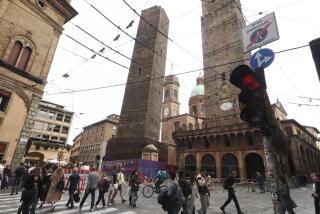Status Towers Dot an Italian Town for 900 Years
- Share via
SAN GIMIGNANO, Italy — Among other things, this tiny town atop an 800-foot hill comes at you strong as a place put on hold.
About 600 years ago San Gimignano had 75 tall towers, but today only 13 are left. They form a skyline (not unlike that of a mini-New York City) which, as you approach it, may be one of the most jarring and exhilarating high spots in all Italy; the Italian Government has decreed that the entire town be classified a national monument, an honor accorded no other city on The Boot.
Thus San Gimignano, soaring above the Tuscan countryside midway between Florence and Siena, is one big fantastic live-in museum. Known as “the town with the beautiful towers,” San Gimignano is a people-busy hub for a good five months each year. Italian tourists from all over and schoolchildren on field trips with teacher flood in to see the giant stone towers from afar and near. No one is ever disappointed.
A Long History
Eventually the big question arises, how come? The history of the towers reads almost like fiction, Hollywood style. The tour guides go into orbit dispensing pop history, and the souvenir shops therefore sell more soft-cover San Gimignano history books (with 196 color photographs) than they do souvenirs, a first anywhere.
Although the town’s origins go back to pre-Roman times when the Etruscans built a settlement here, San Gimignano came into its own during the 12th Century when it got mixed up in the constant political and military squabbles between Florence and Siena. Consequently, the 4,000 residents, primarily for their own protection against their two enemy city-states, surrounded the town with a massive wall, making it into a fortress city.
But that didn’t quite work. For whenever either Florence or Sienna attacked, the wall of San Gimignano was inevitably penetrated and the locals had to fight the bad guys in the streets and back alleys anyway.
One Hot Solution
Then someone got a hot idea. The best way to ward off professional soldiers was to pour boiling oil on them, or bubbling tar or some other unpleasant mixture.
Rich persons in San Gimignano built their homes in the form of tall towers, most of which were about 150 feet high, had one door and one or two apertures at the top. Directly inside the openings were wooden scaffolds from which the defenders could pour the hot liquid from caldrons. The towers became a status symbol for moneyed families.
That worked for many decades. The enemy was kept at bay. But then in 1354, thanks to the ravages of the Black Plague that decimated the population, Florence managed to conquer the city anyway at great loss of life, and if nothing else, it brought peace to San Gimignano.
Peace brought on an urban renewal program, and many of the 75 towers underwent dismantling because none was considered architecturally aesthetic. Besides, the travertine stones used were quite reusable and therefore salable to builders eager for the sturdy blocks.
An Architectural Catch
There was a catch. Some of the towers had been built so well that the demolishers had a lot of trouble knocking them down. They gave up when 13 were still left, and these, for five centuries, have been standing virtually intact and have withstood the elements with no deterioration.
Guarded by Italy’s Fine Arts Commission and the Province of Tuscany, the remaining towers are used as homes and places of business. The tallest of the 13 towers is the Torre Grossa, which is attached to City Hall and whose interior can be visited with guided tour groups.
The best way to see all the towers on foot is by walking along the main street from the 13th-Century gates of San Giovanni and San Matteo. It winds into a dirt road a few meters outside the town.
San Gimignano has a lot to offer art buffs, with its glorious frescoes in the churches. From the Renaissance you can drink in the brilliant sacred art of Ghirlandaio and many other Sienese masters of the 13th and 14th centuries. A walk along the city’s ramparts is very much recommended, as are the decorative cycle of New Testament frescoes by Barna of Siena and the three stupendous frescoes of the Last Judgment by Taddeo di Martolo.
During warm weather, San Gimignano’s main square, reminiscent of a movie set, is dotted with chairs and tiny tables for some dolce vita , lazy life over a cuppa. At time the square is used for film festivals, evening operas and rock shows. This is one medieval town that is not stone dead, for its towers alone are enough to one-up any city.
More to Read
Sign up for The Wild
We’ll help you find the best places to hike, bike and run, as well as the perfect silent spots for meditation and yoga.
You may occasionally receive promotional content from the Los Angeles Times.






